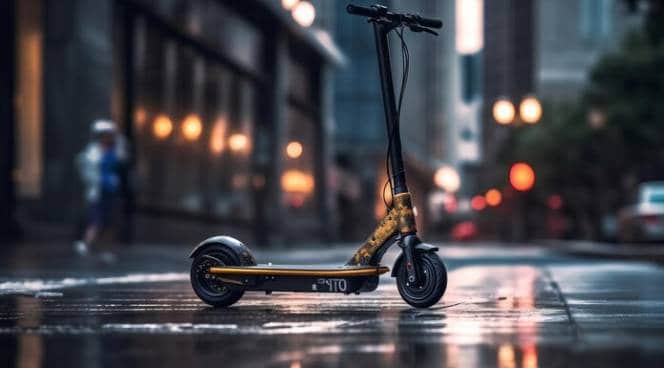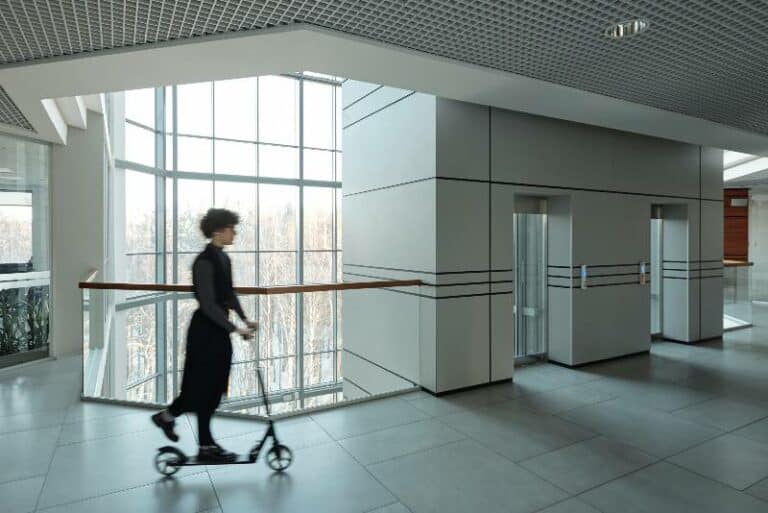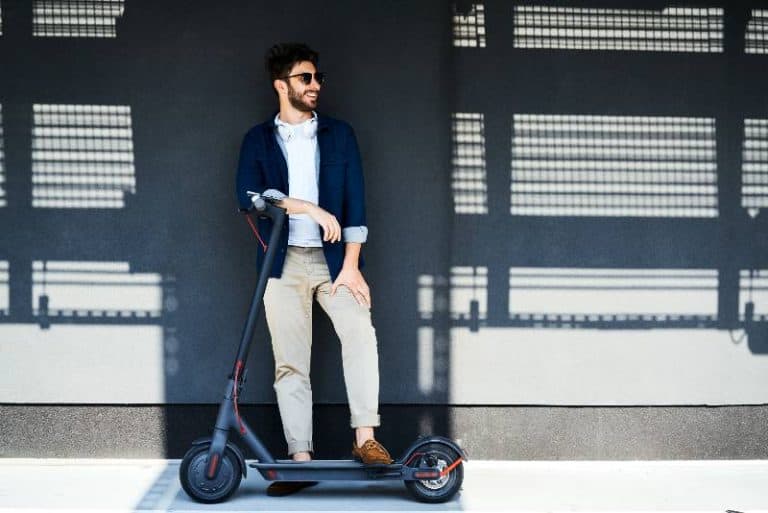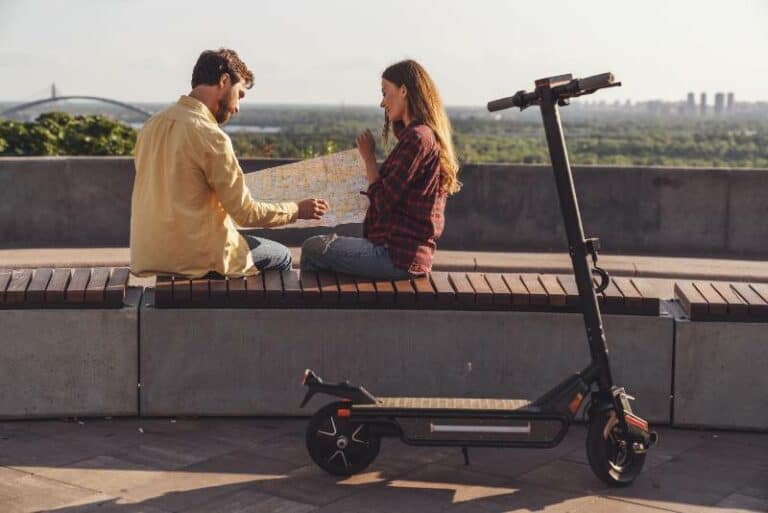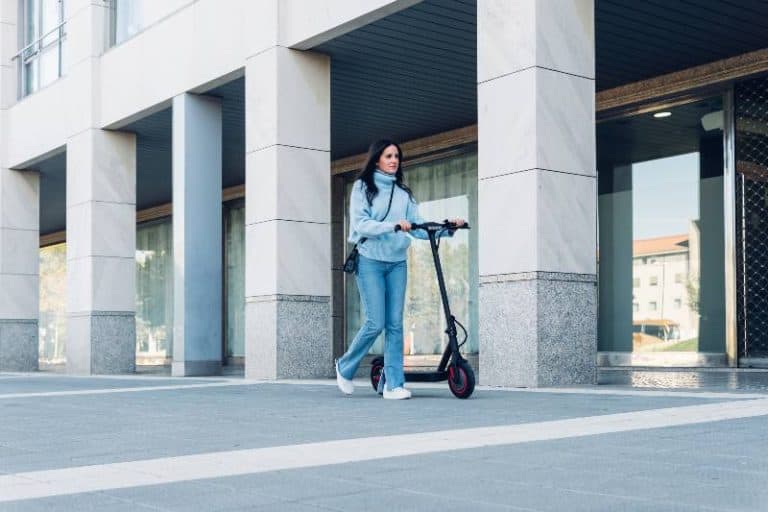Waterproof Winners: Top Electric Scooters for Rainy Rides
Are you looking for a way to beat the traffic and enjoy some fresh air while commuting? It can be challenging to navigate through dense, busy streets but with the right electric scooter, you can quickly get around without having to worry about arriving soaked from riding in the rain. Whether you’re an avid fan of outdoor sports or just eager for a cleaner form of transportation, owning an electric scooter is incredibly appealing. The key lies in finding one that is both reliable and capable enough to handle wet weather conditions reliably.
In this blog post, we’ll delve into which type of electric scooters are best suited for riding in the rain so you can make sure your commute remains safe and enjoyable even during downpours! Keep reading as we reveal all our top tips on choosing the perfect model today!
When riding in the rain, it is crucial to use electric scooters specially designed for such conditions. Give priority to scooters with excellent water resistance (IP ratings), durable construction, superior tire grip, and enhanced safety features. Always consider features like battery protection, visibility add-ons, and reliable braking systems. Top brands often offer models specifically tailored for wet conditions, ensuring a smooth, safe, and efficient ride even in inclement weather. Remember, safety should always come first!
Key Takeaways
- It’s crucial to consider factors like water resistance, tire tread, and safety features when choosing an electric scooter for rainy weather.
- Regular maintenance and safety precautions can enhance the lifespan of your scooter and ensure safe commuting during rainy conditions.
- Investing in the right electric scooter designed for wet weather conditions provides confidence and reliability during rainy commutes.
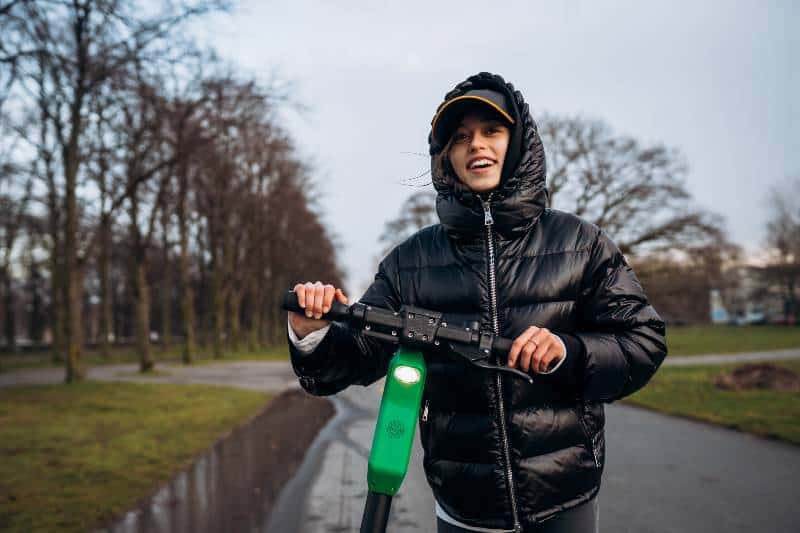
Factors to Consider When Choosing an Electric Scooter for Rainy Weather
Water resistance or waterproof ratings (IP rating)
Most electric scooters have an IPX4 rating. The IP (Ingress Protection) rating is crucial when considering an electric scooter for rainy weather. It provides a clear measure of how resistant the scooter is to both solid particles and liquids. The higher the IP rating, the better the scooter’s protection against elements like dust and water. For rainy conditions, you’ll want a scooter with a higher second digit in the IP rating, which indicates its water resistance. For instance, IP65 means the scooter is dust-tight and can handle water jets, but not submersion.
Tire tread and grip
The tires play a pivotal role in ensuring stability and safety when navigating wet surfaces. Look for tires with deep treads and patterns that can channel water away, reducing the risk of hydroplaning. In addition, the material of the tire, whether it’s rubber or a compound material, can also impact its grip on wet roads. Air-filled tires tend to offer better traction than solid ones, but they may require more maintenance.
Build quality and material
The construction quality of the scooter and the materials used can dictate how it stands up to regular exposure to wet conditions. Aluminum, for instance, is corrosion-resistant, lightweight, and durable, making it a popular choice. Some scooters might also feature corrosion-resistant coatings or treatments. Ensuring the scooter’s build quality can prevent premature wear and tear due to frequent exposure to moisture.
Safety features (lights, reflectors, etc.):
Riding in the rain often means reduced visibility. Therefore, having bright front and rear lights can be a lifesaver. Reflectors and reflective strips can further enhance your visibility to other road users. Additionally, some scooters may come with electronic anti-lock braking systems, which can be beneficial for stopping safely on wet surfaces.
Battery protection:
Rain and moisture can be detrimental to a scooter’s battery if it’s not adequately protected. A good electric scooter designed for rainy conditions should have a well-sealed battery compartment. Battery protection also relates to how the battery performs in different temperatures, as cold, wet weather can affect battery performance and lifespan. It’s essential to ensure that the battery has a protective casing or layer that shields it from direct exposure to water, ensuring the scooter remains functional and safe to use even after riding in the rain.
Top Electric Scooters Suitable for Rainy Commutes
Wolf Warrior X GT
Have you ever imagined cruising through muddy trails, feeling the splash of water, yet not having the anxiety of getting stuck? The Wolf Warrior X GT, with its impressively grippy hybrid off-road tires, ensures you can. These tires are not just ordinary; they’re designed to conquer wet, muddy conditions with an aplomb that few can match. While we’d always advise you to avoid plunging headlong into deep, treacherous mud, the Wolf Warrior’s high-mounted front fender comes to your rescue, designed ingeniously to resist any clogging from mud splashes.
You might ask, “Why not just have a front-wheel-drive system?” But here’s a fascinating insight into two-wheeled dynamics: More motors don’t necessarily guarantee better traction. The absence of front-wheel drive motorcycles in the market is a testament to this fact.
What’s more exciting about the Wolf Warrior X GT is its dual-motor setup. But wait – there’s a twist! On wet roads, which can be notoriously slippery, you can switch the scooter to rear-wheel drive. The reason is as intriguing as it’s logical: when you accelerate, especially on two wheels, the bulk of the weight shifts to the rear tire.
In rain-soaked conditions, the front tire retains just the right amount of weight. This balance ensures adequate traction for precise steering, without the added risk of trying to both steer and accelerate simultaneously. It’s almost like a delicate dance where the scooter knows exactly when to take the lead and when to follow.
So, if you’re looking for an exhilarating yet safe ride that promises adventure and precision, look no further. The Wolf Warrior X GT is not just a scooter; it’s a statement!
Apollo City Pro
Is your adventurous heart longing for a stylish ride that’s a bit lighter on the pocket, but heavy on performance, especially during those rainy spells? Enter the Apollo City Pro – not just any electric scooter, but a champion built for challenging weathers.
With its remarkable IP66 water resistance rating, it stands tall among its peers, boasting one of the highest ratings in our database. This ensures that come drizzle, shower, or a heavy downpour, the Apollo City Pro remains your reliable companion.
But there’s more to its charm than just weather resistance. The fusion of regenerative braking and drum brakes makes us nod in admiration. Why, you ask? Well, on those treacherously slippery roads, these brakes significantly lower the risk of unpredictable skids, ensuring you have a braking system that’s both responsive and safe.
Add to this the thoughtful inclusion of turn signals, and you’ve got a scooter that’s not just about the ride, but also about ensuring you communicate your intentions clearly to fellow road users. And those 10-inch tubeless tires? They’re a godsend! Flat-resistant and robust, they are the unsung heroes ensuring your rainy rides are not interrupted by the unwelcome surprise of a flat tire.
For tech enthusiasts, the Apollo City Pro also offers deeper control layers, be it through the P-Settings or its nifty app. To make your wet rides even smoother, we’d tip our hats to softer initial acceleration and milder regenerative braking settings. It’s the little tweaks that make the biggest difference.
However, while the Apollo City Pro offers a remarkable grip, always remember the golden rule of wet riding: Smoothness is key. Whether it’s braking, steering, or throttle, keeping your inputs gentle ensures optimal traction. While it might be tempting to zip around at usual speeds, trimming down your pace by about 10% is the trick. Why? Because a rigorous test show that wet pavements typically offer about 90% of the traction of their dry counterparts.
But here’s a little secret – watch out for those sneaky manhole covers and deceptive wet leaves. Our data doesn’t lie, and it screams out loud: they’re slipperier than you’d expect when drenched!
EMOVE Cruiser
Rain or shine, when it comes to the world of electric scooters, there’s one name that echoes above all – one of the best waterproof electric scooter: The Cruiser. Its reputation as the globe’s premier wet-weather commuter is not just a title, but a testament to its exceptional IP67 water resistance rating. For those who find poetry in numbers, IP67 is a symphony that sings of unparalleled resilience against water.
And if your daily journey spans miles that would make others think twice, the EMOVE Cruiser is the rain-soaked chariot you’ve been waiting for. Crowned as our top pick for the best long-range electric scooter for those rainy rides, it promises more than just distance.
Picture this: You’re cruising on a road slick with rain, but beneath you is a rear-wheel-drive marvel boasting full suspension and 10-inch tubeless tires. These features harmoniously combine, ensuring every raindrop and wet stretch is met with a smooth, almost balletic ride. And with an astonishing 50-mile range, the EMOVE Cruiser doesn’t just promise to get you there; it ensures every mile is an embrace of unparalleled comfort.
One of its standout features? The Cruiser’s extended wheelbase. This, combined with its impeccable Fender protection, isn’t just about aesthetics. It’s a blueprint for stability and safety, making your journey on wet roads feel less like a challenge and more like a dance.
However, every dance requires attention to detail. The EMOVE Cruiser’s deck, while grand and spacious, comes with smooth, beveled edges that demand your respect, especially when they’re wet. For those planning to make this scooter their rainy-day companion, we ardently advise enhancing those edges with extra grip tape. It’s a small tweak, but one that can transform your wet weather commuting from good to exemplary.
NIU KQi2 Pro
Meet the NIU KQi2 Pro – our crowned jewel for the best scooter under $600, and its prowess shines even on rainy days. Those magnificent 10-inch tubeless, air-filled tires don’t just ensure a smooth ride and steady ride; they grip the road with an assurance that’s both comforting and commendable.
But there’s more to this scooter than just its stellar ride quality. As dusk settles or when grey clouds loom, the KQi2 Pro doesn’t fade into obscurity. Instead, it makes its presence felt with a radiant halo of light, encircling its high-mounted headline. And for those behind you? A fender-mounted tail light not only illuminates the path but also doubles as a brake light, ensuring your safety is never compromised.
Rain often brings with it concerns about equipment durability, but the KQi2 Pro scoffs at light drizzles with its IP54 rating. Couple that with the synergistic performance of its front drum brake and the regen brake, and you’ve got a scooter that promises impeccable stopping power, all while preventing any dreaded lock-ups.
One can’t overlook the deck either. Adorned with grip tape, it offers superior traction, ensuring that even in wet conditions, you’ll feel as if you’re standing on solid ground.
NIU KQi3 Max
Fancy pushing the boundaries even further than the KQi2 Pro? Enter the NIU KQi3 MAX. This powerhouse doesn’t just add a few extra miles; it boosts your range by a whopping 48%! And it’s not just about covering distance – it’s about doing it confidently. Thanks to its flat-resistant tires, the days of dragging your scooter along in the rain are long gone. No more rain-soaked walks of shame with the KQi3 MAX by your side.
But where this model truly shines (apart from keeping you out of rainy predicaments) is in its braking system. The KQi3 MAX boasts dual braking system, arguably the most formidable stopping power on our list. Given their potency, a word of friendly advice: test them out in a controlled setting, like an empty parking lot. Familiarize yourself with their might, so that when you ride out on that first drizzly commute, it’s with preparedness and confidence.
Reflecting on it, this counsel holds for all scooters, especially when braving wet conditions. A light rain morning isn’t the ideal time to learn your scooter’s quirks, especially when the clock’s ticking and work awaits. Equip yourself with familiarity first, ensuring that when you glide through the rain, it’s with grace, safety, and punctuality.
To gain a deeper understanding of electric scooters and their impact on creating a sustainable future, I highly recommend taking the time to read an article that I personally wrote. Titled “Green Wheels: Electric Scooters for a Sustainable Future,” this article delves into the intricate details of how electric scooters are revolutionizing transportation, their eco-friendly benefits, and the positive implications they have on reducing carbon emissions.
Rain-resistant Electric Scooters vs. Waterproof Electric scooters
Rain-resistant electric scooters and waterproof electric scooters are terms that are often used interchangeably, but they have distinct differences that are paramount for potential users to understand, especially if they are frequently commuting in areas with variable weather conditions.
A Rain resistant electric scooter is designed to handle light to moderate rain or moisture exposure. This essentially means that they can endure occasional splashes, a light drizzle, or brief exposure to rain without suffering significant damage. However, prolonged exposure to heavy rain or submerging them in water may lead to malfunctions or long-term damage. These scooters are typically sealed in a way that keeps out casual moisture, ensuring that minor wet conditions don’t easily interfere with the scooter’s functionality.
On the other hand, waterproof electric scooters boast a higher level of protection against water. When a scooter is labeled as ‘waterproof’, it typically has a specific ingress protection (IP) rating that indicates its degree of protection against both solids (like dust) and liquids (like water). A waterproof scooter can handle more intense and prolonged exposure to water, such as heavy rain or even being submerged in shallow puddles for brief periods, without its performance being compromised or its internal components being damaged.
In choosing between the two, potential buyers should assess the conditions they’re most likely to face. For occasional riders who might get caught in a light drizzle, a rain-resistant scooter might suffice. However, for those living in areas prone to heavy rainfall or for users who don’t want to be overly cautious about water exposure, investing in a truly waterproof scooter would be the wiser, more forward-thinking choice. It’s always recommended to review the manufacturer’s specifications and guidelines regarding water exposure to ensure the longevity and safety of the scooter.
Maintenance Tips for Using Electric Scooters in the Rain
Riding an electric scooter in the rain or wet conditions poses several challenges, both in terms of safety and the long-term health of your scooter. To ensure that your electric scooter remains in top condition and serves you well, follow these maintenance tips when using it in rainy conditions:
1. Proper Cleaning After Use:
- Why It’s Important: Wet conditions can lead to the accumulation of mud, debris, and other contaminants on your scooter. Over time, these can corrode the parts and degrade the performance of the scooter.
- How to Do It: After every wet ride, rinse off the scooter with clean water to remove any contaminants. Ensure you remove any mud or debris stuck in the crevices. Use a soft cloth to dry off the scooter thoroughly. Do not use a high-pressure hose as it can force water into sensitive areas.
- Example: Imagine riding through a puddle and the muddy water splashing onto your scooter’s undercarriage. If not cleaned, this mud can dry and harden, making it more difficult to remove later and potentially causing damage to the scooter’s components.
2. Battery Care:
- Why It’s Important: The battery is the lifeblood of your electric scooter. Exposure to moisture can damage the battery, reducing its lifespan and efficiency.
- How to Do It: Always ensure that the battery compartment is sealed tight and free from any cracks. If you suspect water may have entered the battery compartment, open it up, remove the battery, and allow everything to dry completely before reassembling. Consider using a silicone sealant for an added layer of protection against moisture.
- Example: Think of your battery like a smartphone. You wouldn’t want your phone to get wet, and the same care should be applied to your scooter’s battery.
3. Storing the Scooter in a Dry Place:
- Why It’s Important: Continuous exposure to moisture can lead to rusting of metal components and degradation of non-metal parts.
- How to Do It: After every ride in the rain, store your scooter in a dry, covered place. If you don’t have a garage or shed, consider buying a waterproof scooter cover. This not only protects against rain but also from dew and humidity.
- Example: It’s like parking your car under a shade during a hot summer day. The added protection can significantly extend the life and looks of your vehicle.
4. Regularly Checking the Tire Condition:
- Why It’s Important: Wet conditions can make roads slippery, and worn-out tires can compromise your safety when riding.
- How to Do It: Regularly inspect the tires for any signs of wear and tear. Check for proper tire inflation, ensuring they are not under or over-inflated. Replace tires when the tread depth becomes shallow or if there are visible damages.
- Example: Remember, tires are the only point of contact between the scooter and the road. Like worn-out shoes that can make you slip, worn-out tires can make your ride dangerous.
Remember, while maintenance is crucial, always prioritize your safety. If the weather conditions are too severe, it might be best to avoid using the waterproof electric scooter altogether. Always wear appropriate safety gear, including a helmet, and ensure your scooter’s lights and reflectors are in good condition, especially in reduced visibility conditions.
Safety Precautions When Riding in the Rain
Riding in the rain presents unique challenges and hazards, making it essential to prioritize safety above all else. Here are some safety precautions to consider when riding in the rain:
1. Slowing Down on Wet Surfaces:
- Why It’s Important: Wet surfaces reduce the traction between the road and your tires, increasing the chances of skidding or hydroplaning.
- How to Do It: Reduce your speed, especially when turning or maneuvering around obstacles. Also, avoid sharp turns and sudden braking, as these actions can lead to loss of control.
- Example: Think of it as walking on an icy path. You’d naturally move slower and more carefully, and the same caution should be applied when riding in the rain.
2. Avoiding Flooded Areas:
- Why It’s Important: Flooded areas can hide potholes, debris, or other hazards. Additionally, deeper waters can reach critical components of your ride, leading to malfunction or permanent damage.
- How to Do It: Always choose routes that are less prone to flooding. If you come across a flooded area, it’s safer to dismount and walk or find an alternative route.
- Example: It’s like driving a car into a large puddle without knowing its depth. There’s a risk of stalling or damaging your vehicle, so it’s better to be safe and avoid the area altogether.
3. Using Waterproof Gear:
- Why It’s Important: Getting wet can not only be uncomfortable but can also reduce your ability to operate controls effectively, putting you at risk.
- How to Do It: Invest in quality waterproof gear such as jackets, pants, gloves, and footwear. Consider a waterproof cover for your backpack or belongings as well.
- Example: Imagine using a smartphone with wet fingers. The screen doesn’t respond well, right? Similarly, operating controls like brakes or throttle with wet hands can be less efficient and risky.
4. Being More Visible to Other Commuters:
- Why It’s Important: Rain and wet conditions reduce visibility. Other commuters, be it drivers, pedestrians, or fellow riders, may find it harder to see you.
- How to Do It: Wear brightly colored or reflective clothing. Ensure your lights (front, rear, and side) are fully functional and turned on, even during the daytime. Consider adding reflective tape or stickers to your ride and gear.
- Example: Think of a lighthouse on a foggy night. It stands out and guides ships safely, and similarly, your visibility tools will help others on the road be aware of your presence.
Always be attentive to your surroundings when riding in the rain. Remember that road conditions can change rapidly, and other commuters might also be struggling with the wet conditions. Stay vigilant, practice defensive riding, and always prioritize safety. Safe travels!

Best Electric Scooters Riding Rain FAQs
Are all electric scooters waterproof?
No, not all are completely waterproof electric scooter. Some manufacturers may claim their products are waterproof, but it’s best to double-check the features and specs before investing in one. Waterproof scooters usually have sealed battery compartments that protect against rain and water splashes.
How do I check the waterproof rating of an electric scooter?
Most manufacturers will list the waterproof rating of their products. If it’s not explicitly mentioned, you can try contacting customer service or check online reviews for more information. Usually, electric scooters with a waterproof rating of IP54 or higher are considered suitable for rain and water splashes.
Is it safe to charge my scooter right after riding in the rain?
Yes, it is safe to charge your scooter right after riding in the rain. However, it’s important to make sure there’s no water in the battery compartment or on other electronic components. If you’re unsure, consider leaving it for a few hours and try again when it’s dry.
How frequently should I check my scooter’s tire condition?
In general, it’s recommended to inspect your scooter’s tires every two weeks or before long rides. Pay special attention to the tire condition when riding in wet and slippery conditions. Make sure they are properly inflated and replace them as needed.
Can prolonged exposure to rain damage the battery?
Yes, prolonged exposure to rain can damage the battery. To prevent this from happening, try to store your scooter in a dry and sheltered area when not in use. If possible, consider investing in a waterproof cover or an enclosed storage space for your electric scooter.
Conclusion
All in all, to ride safely and efficiently during rainy conditions, it’s essential to choose an electric scooter designed for wet weather. Make sure it is equipped with features like water resistance, tire tread, and additional safety covers. You should also keep up on regular maintenance of your e-scooter and take the necessary precautions while commuting. Investing in the best waterproof electric scooters tailored for rainy days gives you the peace of mind that you’ll stay safe no matter what kind of weather you’re facing. And make sure to subscribe to our newsletter electrik living for more information about solar and saving the Earth!
